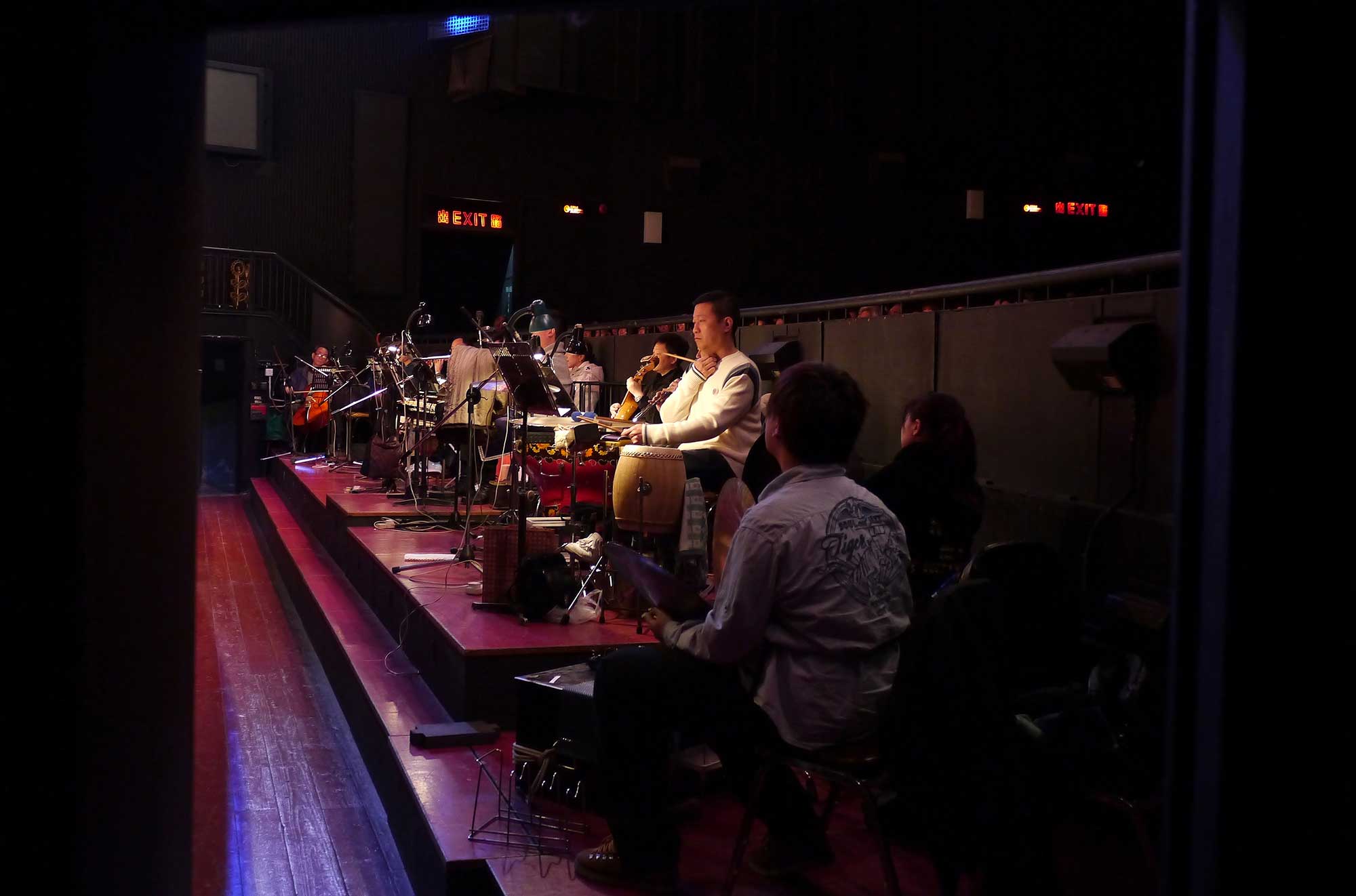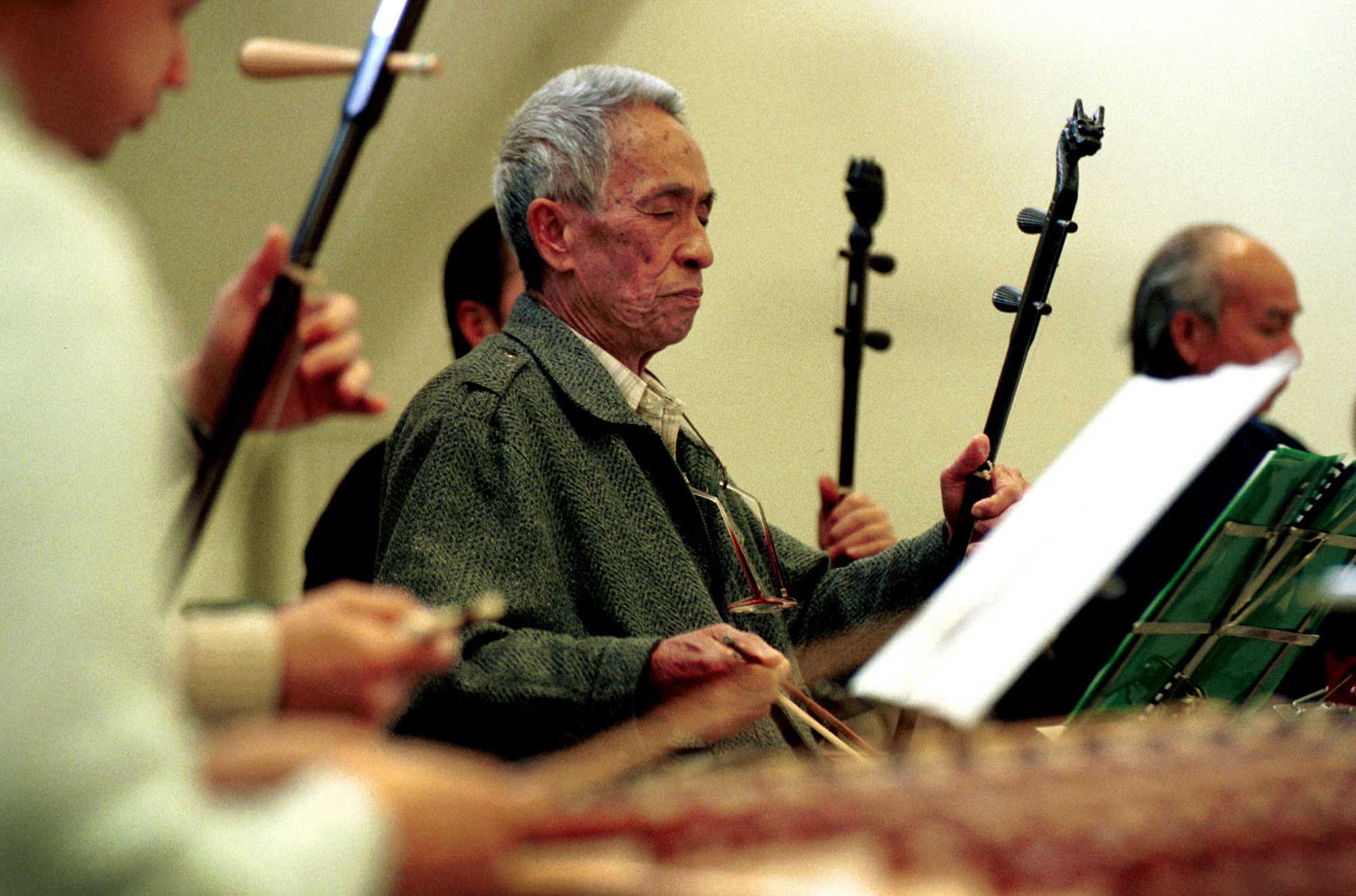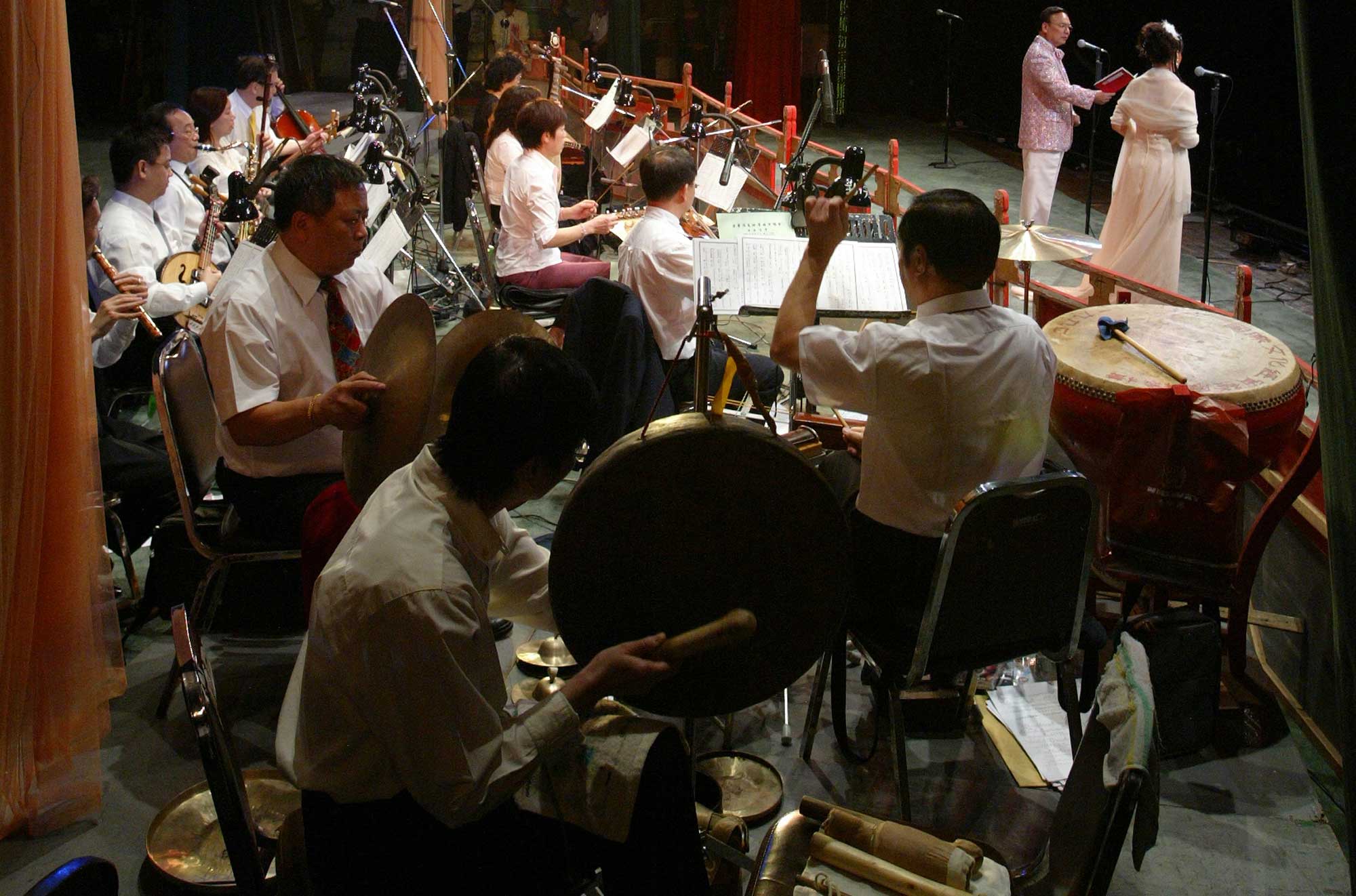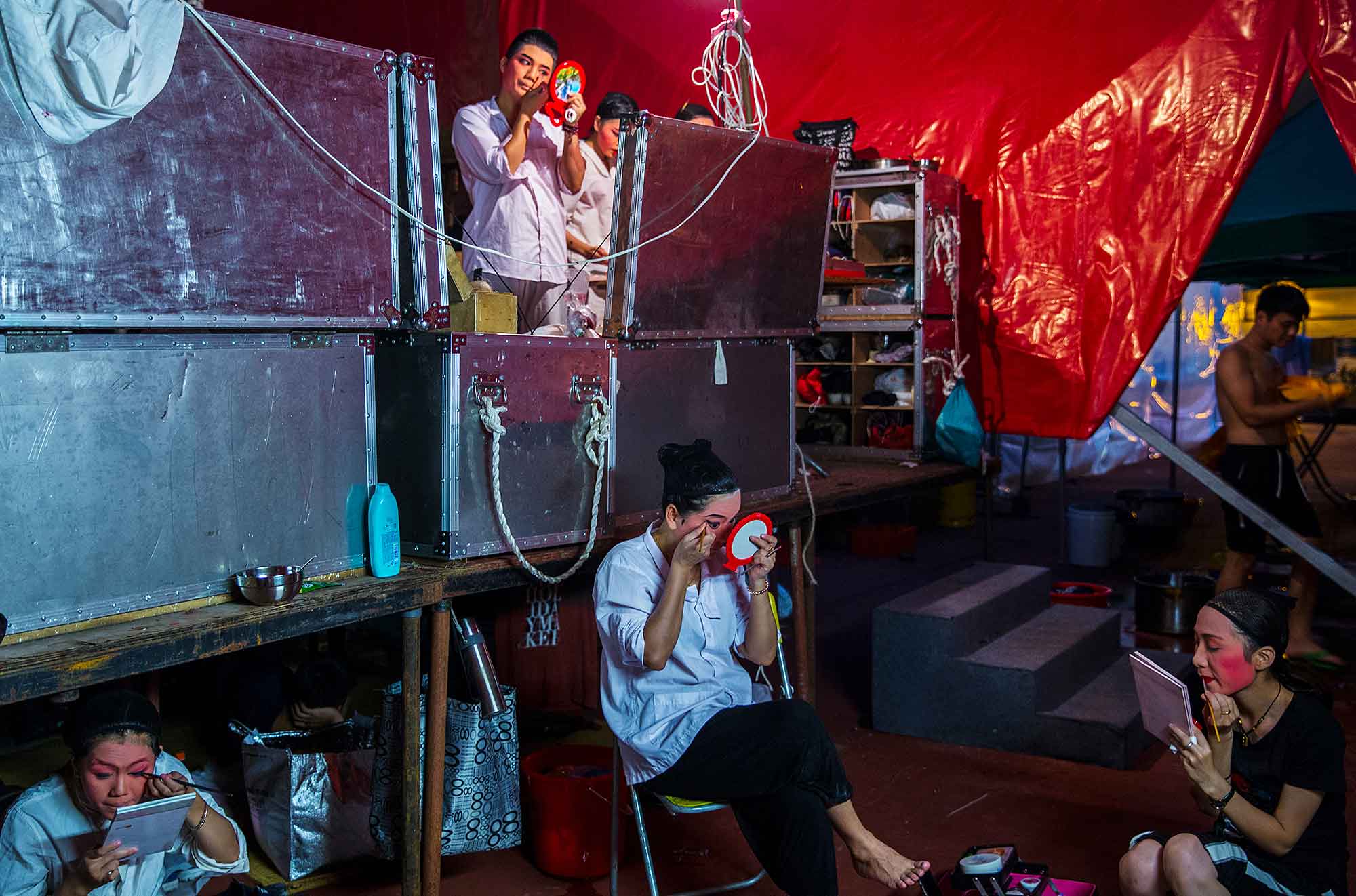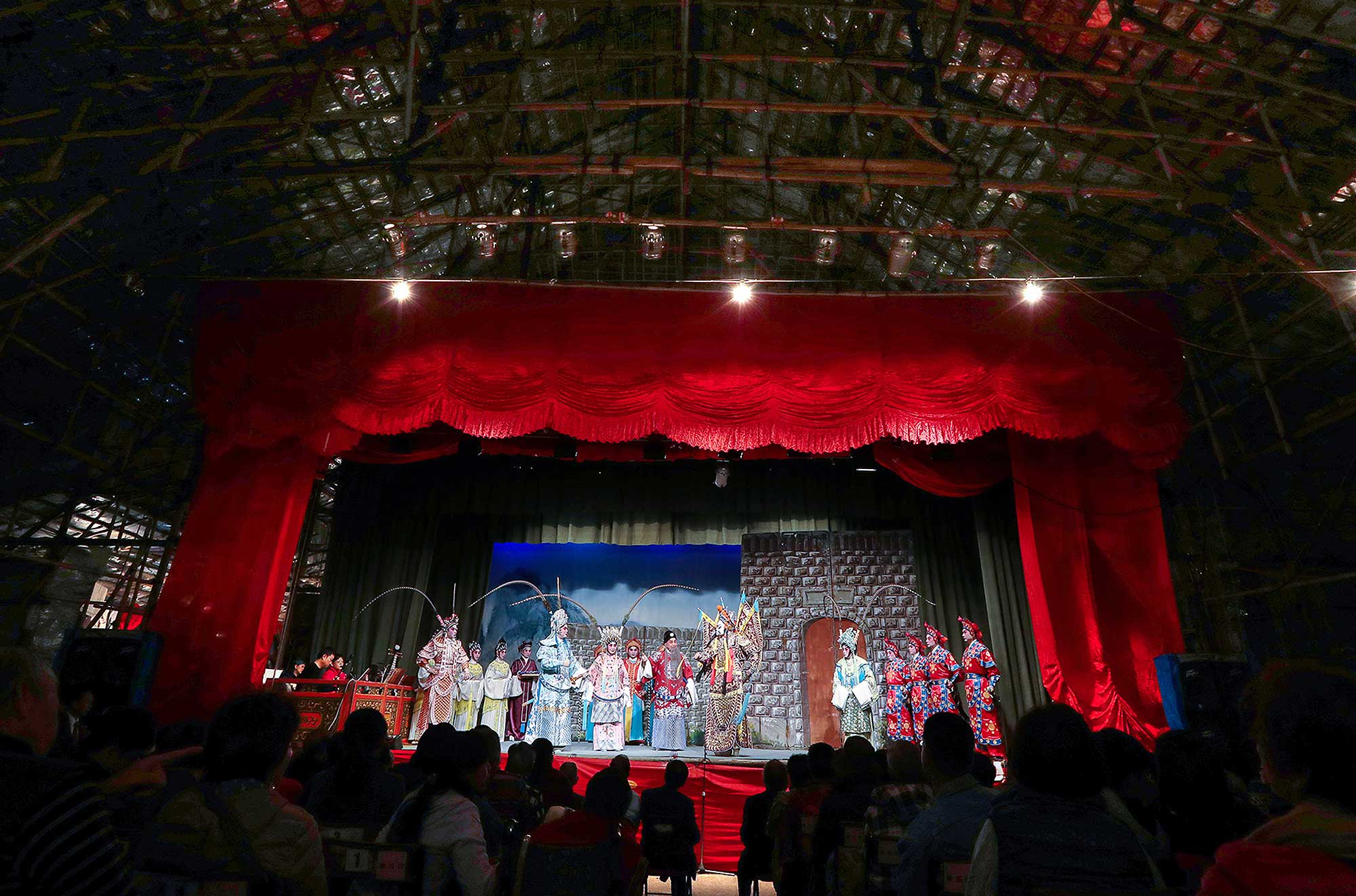HISTORY
Chinese opera is considered to have begun in the Tang dynasty under Emperor Ming Huang (712-755) who founded Pearl Garden, the first operational troupe in China. The exact origins of Cantonese opera are open to debate but the general consensus is that the art form migrated from the north to the southern province of Canton (Guangdong) during the Song dynasty (1179-1276 AD). Cantonese opera is generally thought to have evolved out of Nan Xi, or Southern drama which was performed in public theatres in Hangzhou in the 12th century. The first incarnations of Cantonese opera were also known as Yuet Kuk.

Peking and Cantonese opera share the same origins and as a result similar characters appear in both disciplines. The images above are from the “One hundred portraits of Peking opera characters”, late 19th-early 20th century, Metropolitan Museum of Art.
Another important influence on the Cantonese form is a 16th-century type of opera called Kunqu which originated in Suzhou and is often considered “the mother of Chinese operas”. Its original style included the rich cultural features of Suzhou but it incorporated features from other forms of Chinese opera as it expanded into other regions. Kunqu was known for its powerful stage presence through the use of elaborate make-up, soft and graceful singing, elegant actions and traditional music.
TIMELINE
Mid-19th to 20th century (KEEP SCROLLING)
The red boat
Itinerant troupes performed along the Pearl River Delta from the 19th century to the early 20th century. The groups lived on boats painted red which were able to transport the entertainers to various temple festivals during the performance season. A company normally stayed in a city for a few days, performing different repertoires each day.
The works were presented on stages temporarily erected near temple festivals. The temples offered presentations to the local gods and raised funds that were used to pay the actors with entire communities turning out to watch the shows.
In the mid-19th century, permanent theatres were not built in southern China because touring was still more convenient than owning land and building a theatre.
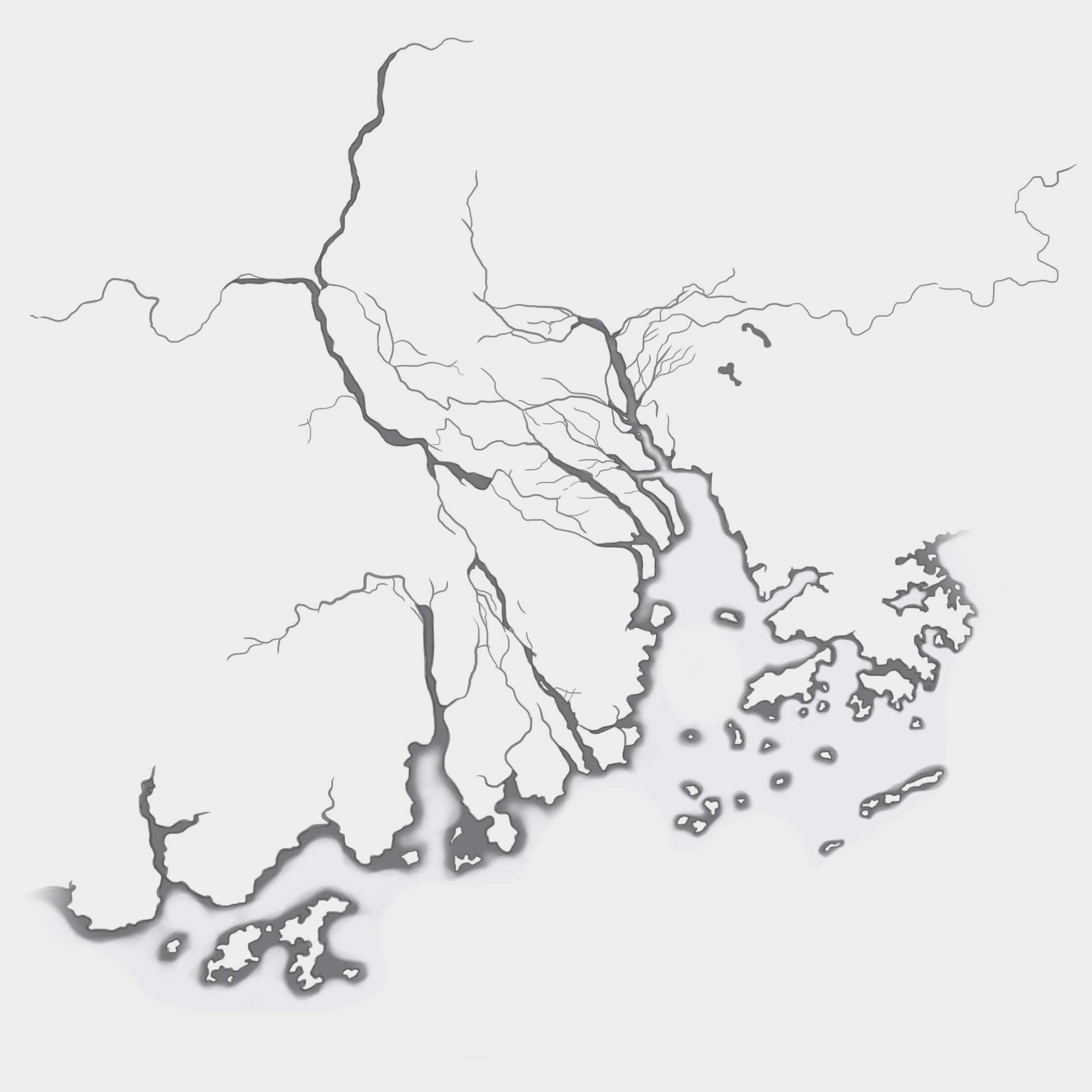
The boats and troupes
The red boats were specially designed for opera troupes and served as sleeping quarters for performers, musicians, apprentices, stagehands, and sailors alike.
Troupes observed a rigid set of rules and conventions regarding the allocation of beds in the cabins and division of labour among the artists. The troupe system and regulations which evolved continue to hold sway in Hong Kong today.
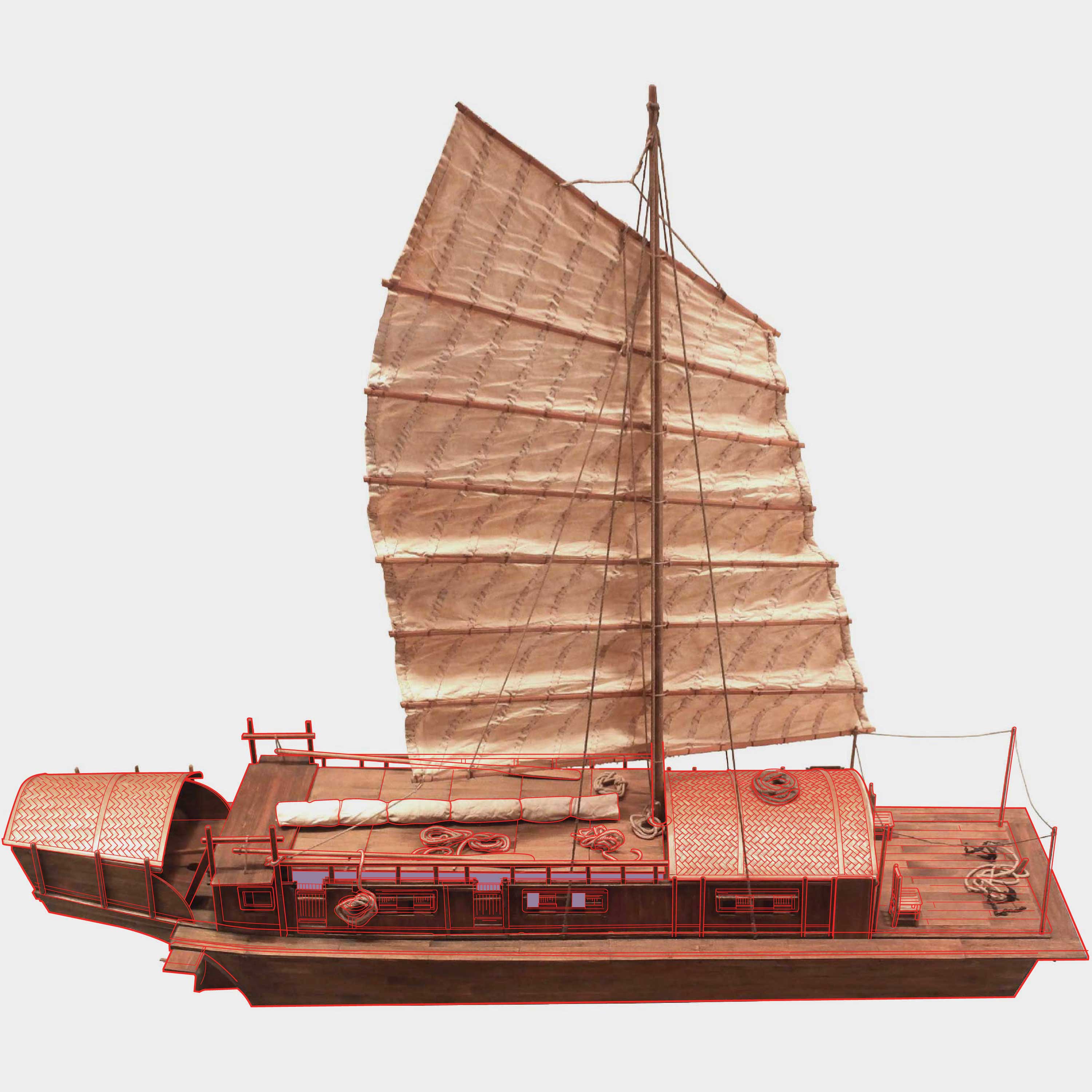


Why red?
There are many different opinions and beliefs. Some people say that the Qing Dynasty stipulated that boats or ships from different provinces should be distinguished by their unique colours. Red was the designated colour for the province of Guangdong.
Others say that the red boat was built in the name of a Guangdong merchant ship, and the merchant ships are mostly red.
Most of the old Cantonese opera artists think that the boats were painted red for good luck. Red is eye-catching, and the people on shore would be able to see the boats approaching from afar and tell everyone the troupes were coming and raise a sense of anticipation and excitement in the community.
Composition of a red boat opera crew
The red boat troupes were highly organised societies. There were 36 opera troupes in total and each full troupe had a staff of 140 to 160 people. Most troupes were all-male until some all-female casts emerged in 1919. In 1933 the prohibition against mixed gender troupes ended.
Many red boats were destroyed during the Japanese invasion of China and most were forced out of use by 1938. After the war, troupes were more likely to use industrial steamer ships to travel between permanent theatres in industrialised cities. The last known sighting of a red boat was in Macau in 1951.

Late 19th century to present
Purpose-built theatres
By the start of the 20th century the theatre business was developing rapidly as Chinese communities growing in prosperity showed a demand for leisure and entertainment. Purpose-built theatres could provide more entertainment choices for citizens.
In 1904, the Tai Ping Theatre was opened in Western District. Equally popular were Ko Shing Theatre and Chung Hing Theatre (formerly known as Tung Hing Theatre) in Sheung Wan and Western District. In 1911, the Kau Yue Fong Theatre, also known as the New Theatre, was opened in Central.
Demolished in February 1981, Model
(Hong Kong Heritage Museum)
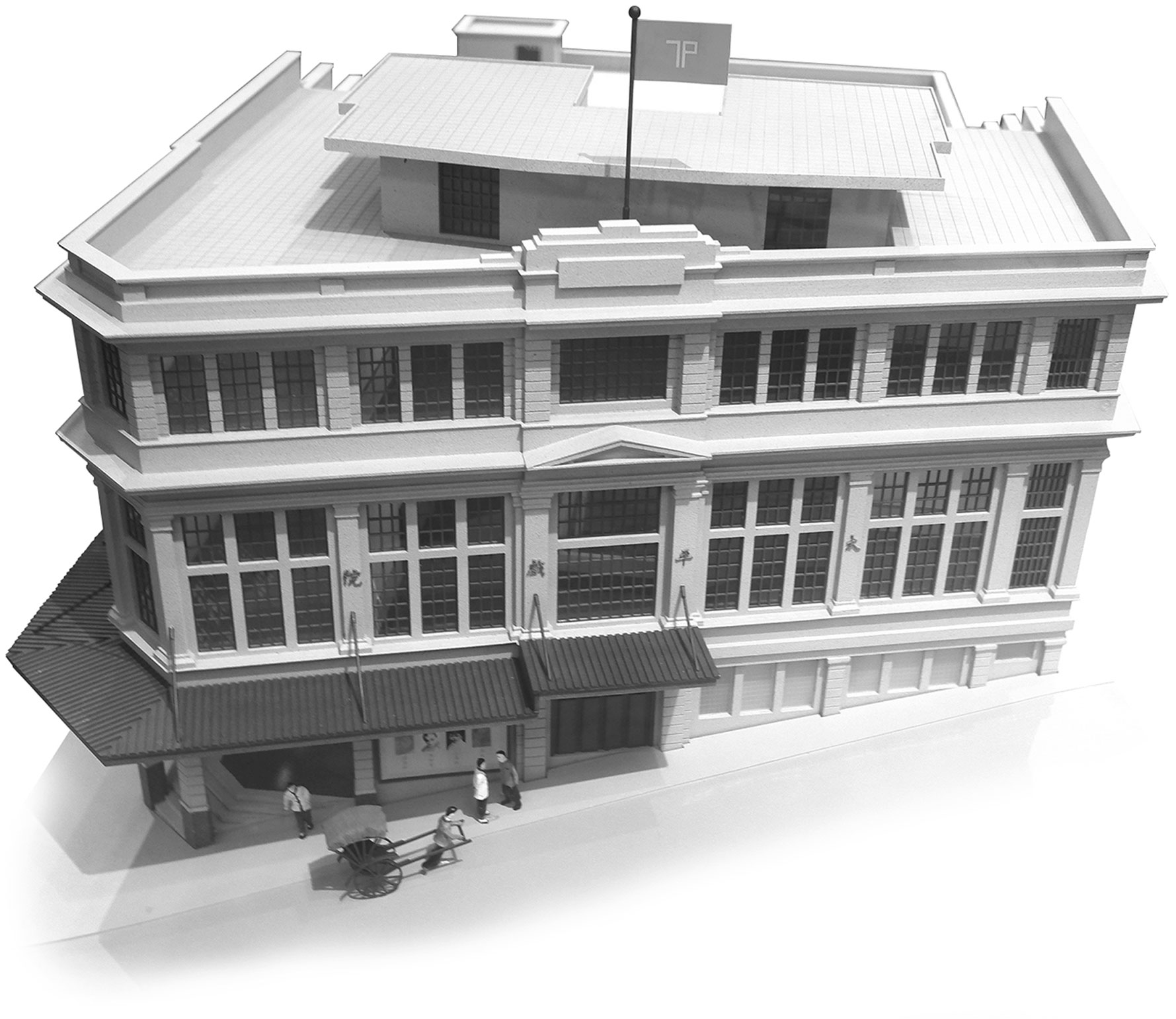
Lane
As the population gradually increased on the east of Hong Kong Island, more purpose-built theatres – including Hong Kong Grand Theatre and Lee Theatre – were built there. The demand for entertainment also grew with the expanding population in the Kowloon Peninsula. The completion of Astor Theatre, Pei Ho Theatre and Prince’s Theatre served as new venues for Cantonese opera performances too.
After World War II, the film industry in Hong Kong started to prosper and the booming business attracted many Cantonese opera stars to switch to the silver screen. The low-price of film tickets appealed to audiences, and the box office for live Cantonese opera performances began to drop drastically. Together with the introduction of television, the Cantonese opera business started to decline in the late 1960s, and few theatres dedicated to Cantonese opera could afford to continue operating.

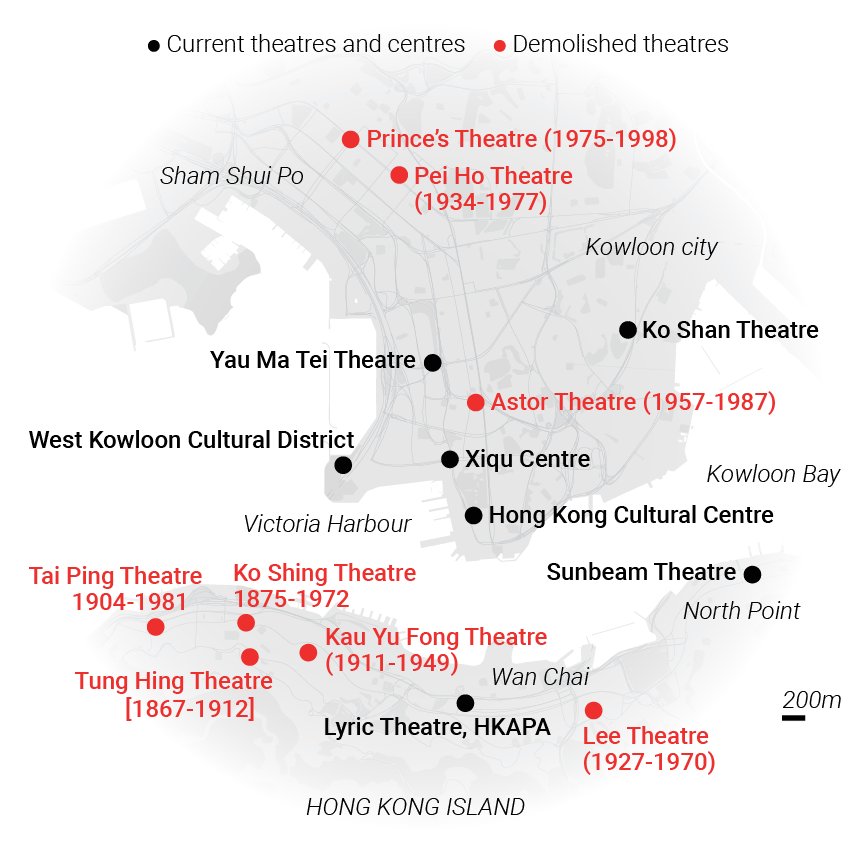
Hong Kong has played an important role in safeguarding Cantonese opera. As well as competition from the silver screen, the tradition came under threat during the Cultural Revolution.
From 1966-76 it was banned in Mainland China, with only eight "model operas" based on Peking opera allowed. The ban was lifted after the Cultural Revolution ended, but by then practitioners had either fled to other countries or quit the profession.
From the 1970s to the 1980s, Hong Kong’s economy and land prices rocketed. Many proprietors sold their theatres for commercial or residential developments.
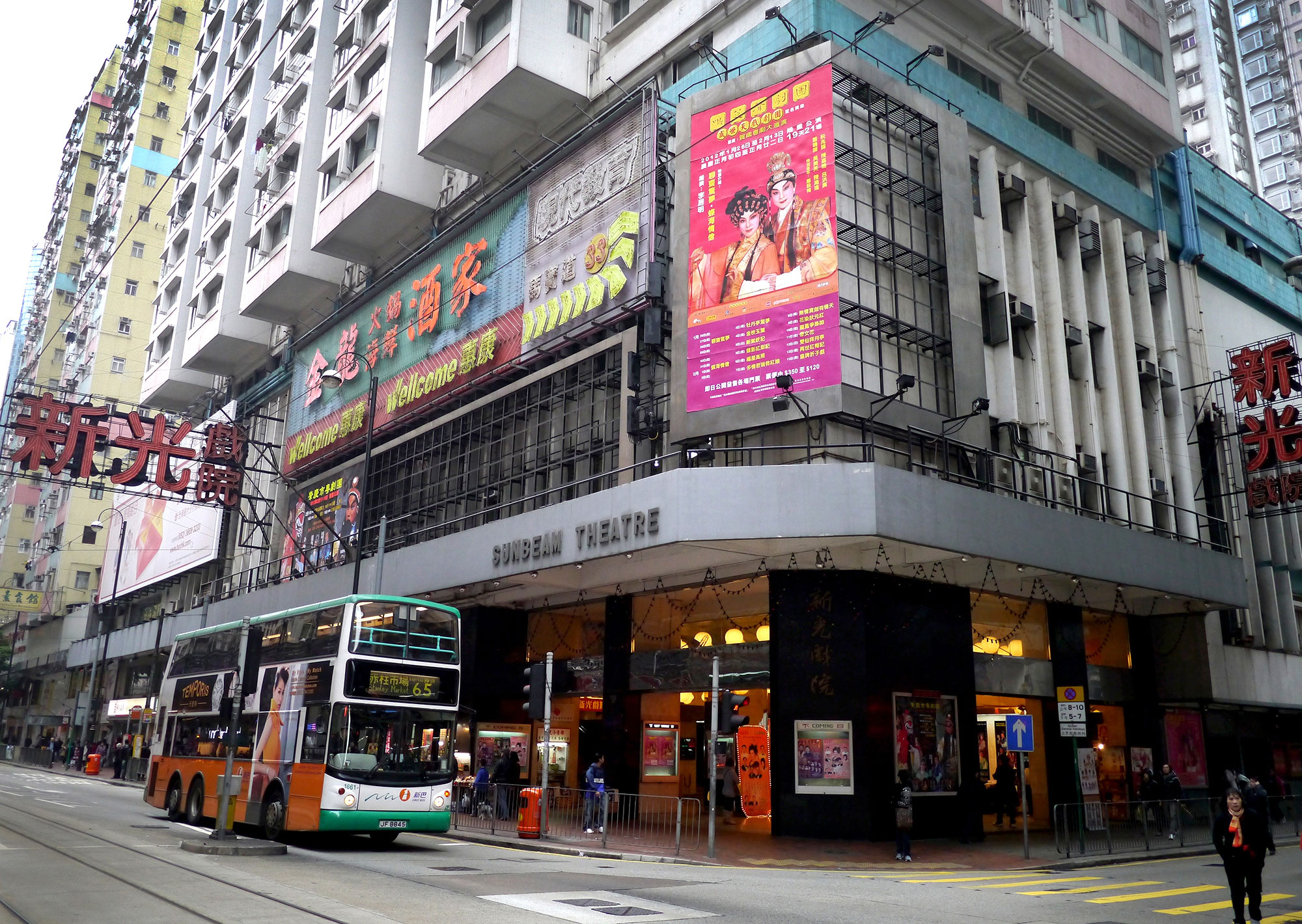
Today, the Sunbeam Theatre is the only commercial theatre still specialising in Cantonese opera. Accommodating over a thousand seats, it is the pre-eminent venue for many renowned Cantonese opera troupes.
Contemporary
Bamboo shed theatres
Bamboo is one of China’s oldest building materials and is traditionally used for scaffolding, particularly in southern China where it grows in abundance.
Bamboo is an indispensable construction material in Hong Kong. It is lightweight, flexible, easy to handle and can be adapted to different styles of construction and varied topological conditions.
Bamboo shed theatres are built for a brief span to house the plays. Traditionally, religious performances of Cantonese opera were open to the public, who enter the theatre from any direction. The theatre is an open venue featuring a vague boundary between audience and performers.
and tin-sheet

The building technique has been listed as the Intangible Cultural Heritage of Hong Kong
bracing
The top portion of the theatre is usually decorated with a banner announcing the title of the event, the name of the troupe and names of the major actors
for the entrance decoration
of the programme
THE INTERIOR OF A BAMBOO THEATRE
The venue provides seating for the audience, a stage and a backstage. The roof covers the entire venue so the audience can enjoy plays, come rain or shine.

2009
Cantonese opera was included in Unesco's Representative List of the Intangible Cultural Heritage of Humanity.
2019
Modern opera centre
A world-class arts venue dedicated to promote the rich heritage of xiqu which includes other Chinese opera genres such as Beijing or Peking Opera, Kunqu Opera, etc.
THE PERFORMANCE
The first experience of Cantonese opera can be a daunting one. With its jarring and intense singing, where words have several intonations and phrases are elongated, the accompanying percussion can seem chaotic and cacophonous to the uninitiated.
However, the noisy percussion accompanies the exaggerated movements of the actors that can be distinctly understood by the entire audience. The vocal style was developed to fill large theatres by projecting the voice over the percussion and noisy audiences.
The use of flashy garments clearly identify the role of each actor. The make-up and contrasting colours applied as face paint helped the audience read the characters’ expressions clearly from any distance in poorly lit bamboo huts with bad acoustics that offered little protection from the natural elements outside. These features that were so relevant to the conditions experienced in the early days have been preserved and continue as the essence of this traditional art form.
THE ROLES
Initially, Cantonese opera’s Xingdang classification, which refers to the different roles according to gender, status and personalities, was similar to other genres. Before the 1930s, there were ten major roles but by the 1950s, liuzhuzhi, the six-pillar system, became firmly established. Each opera features six major actors/actresses including:
1-WENWUSHENG
Sheng is a male character who appears in operas of all historical periods; a civilised martial man, this role portrays as a clean-shaven scholar-warrior.
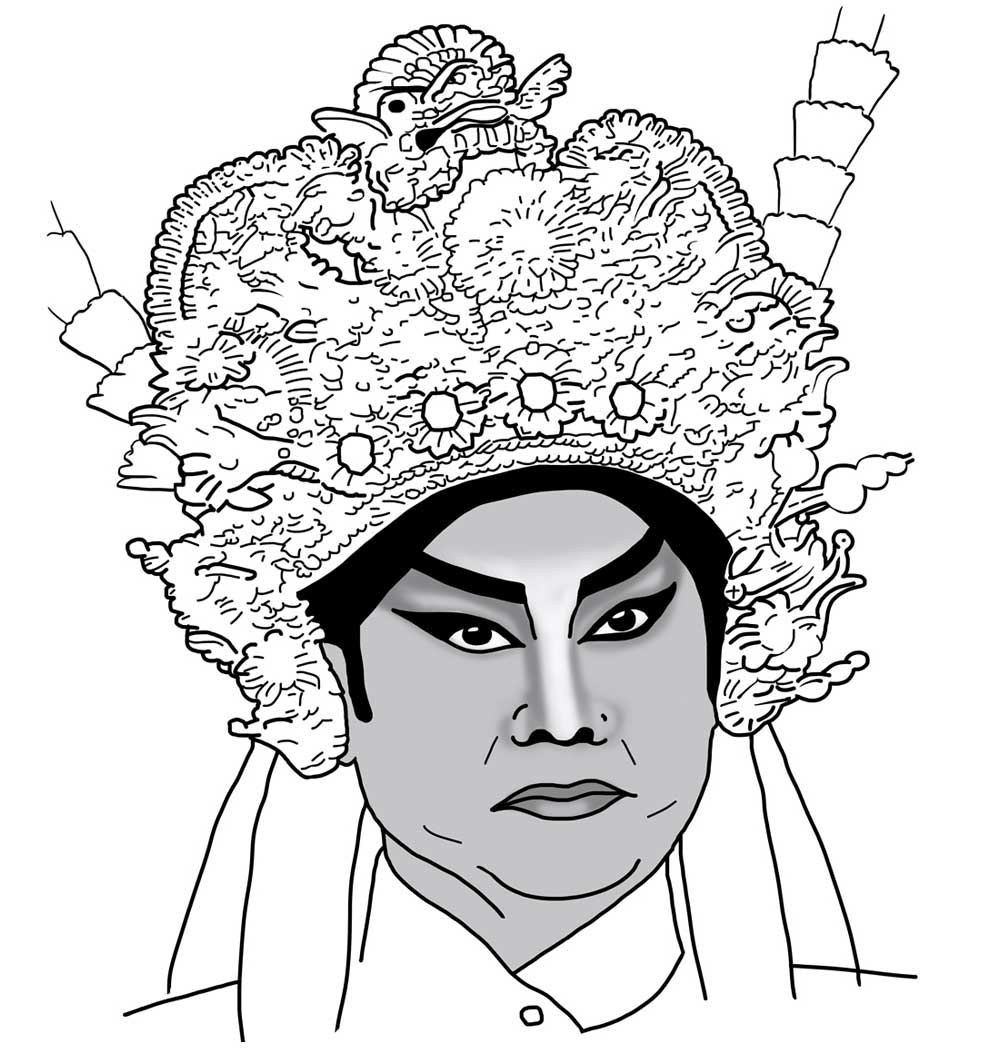
2-XIAOSHENG
Young, beardless male characters. They wear paler make-up to represent their youth. These characters are often involved with beautiful young women.
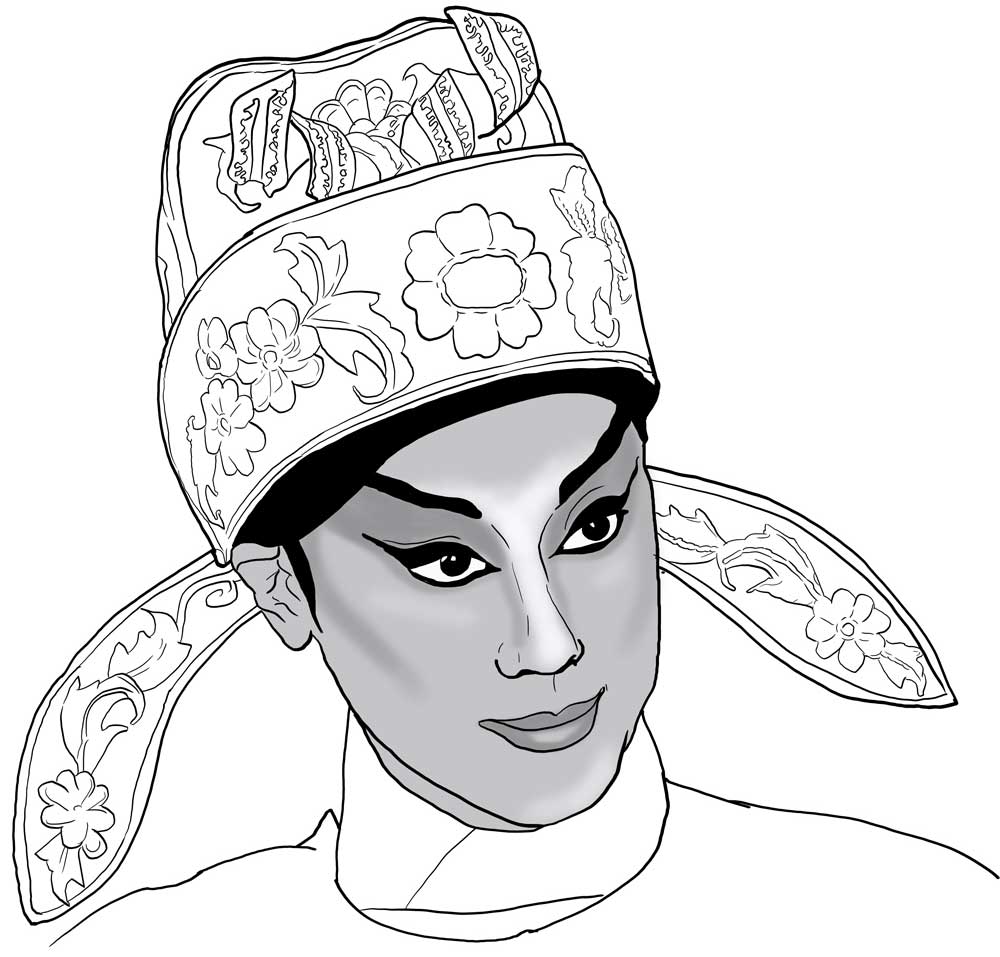
3-ZHENGYIN HUADAN
Hua Dan (Young Belle) is a role for a vivacious maiden; a young woman with a frank and open personality, or a woman of questionable character.
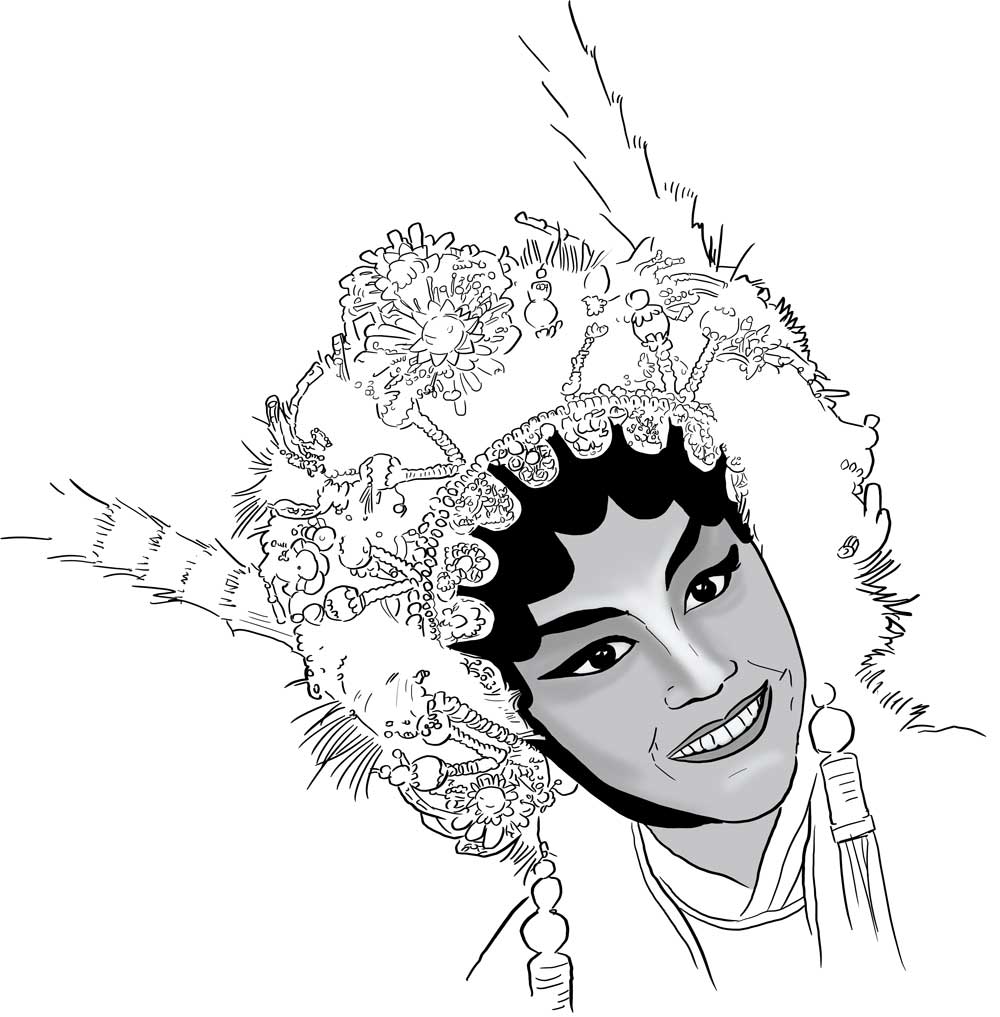
4-ERBANG HUADAN,(SECOND FEMALE LEAD)
A supporting actress; could be an unmarried girl, an honourable lady or an elder female actress playing the role of a mother.
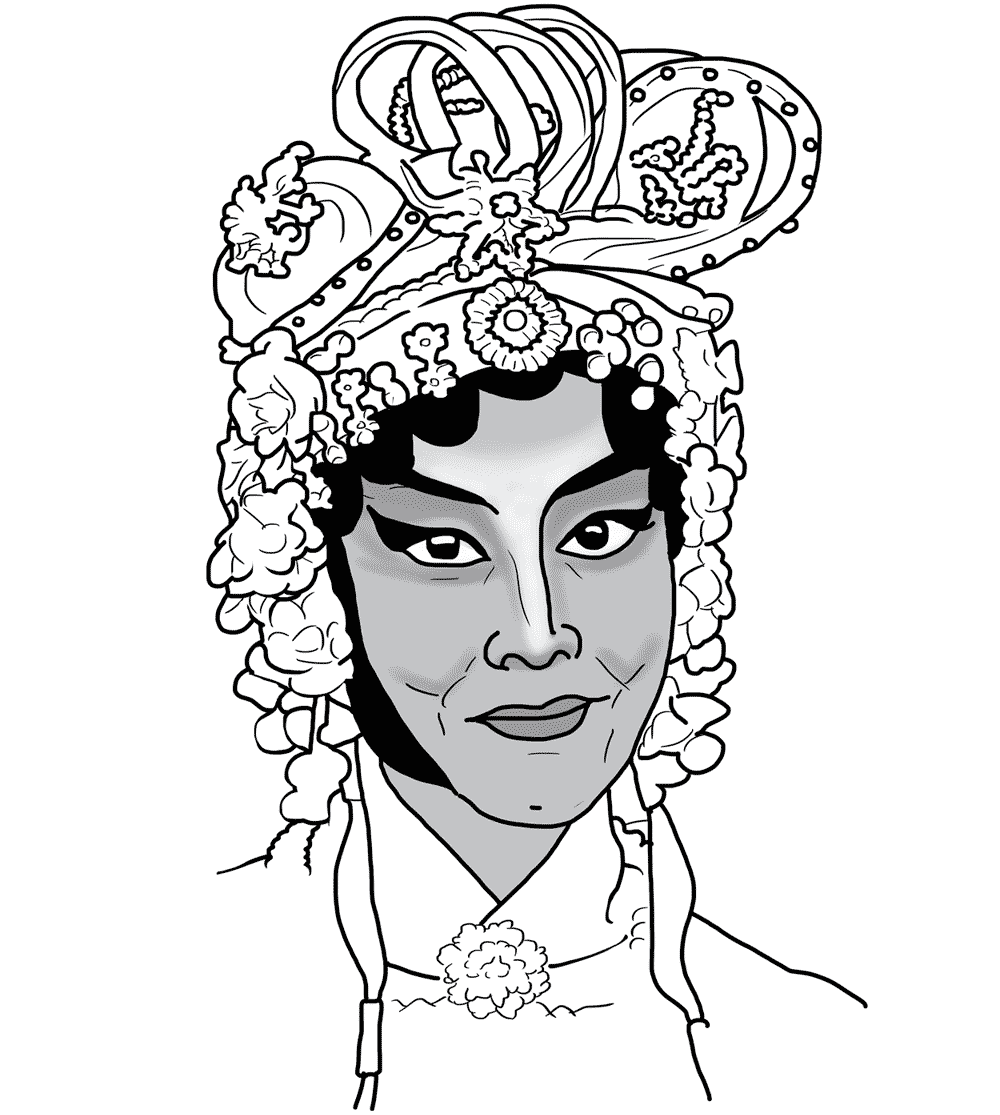
5-ZHENGYIN CHOUSHENG
The Chou (the comic face represents a clown) is always a wise, funny and chivalrous man and is sometimes of low social status. They portray various kinds of personalities, some are warm-hearted, simple and sincere, while others might be sinister and mean.
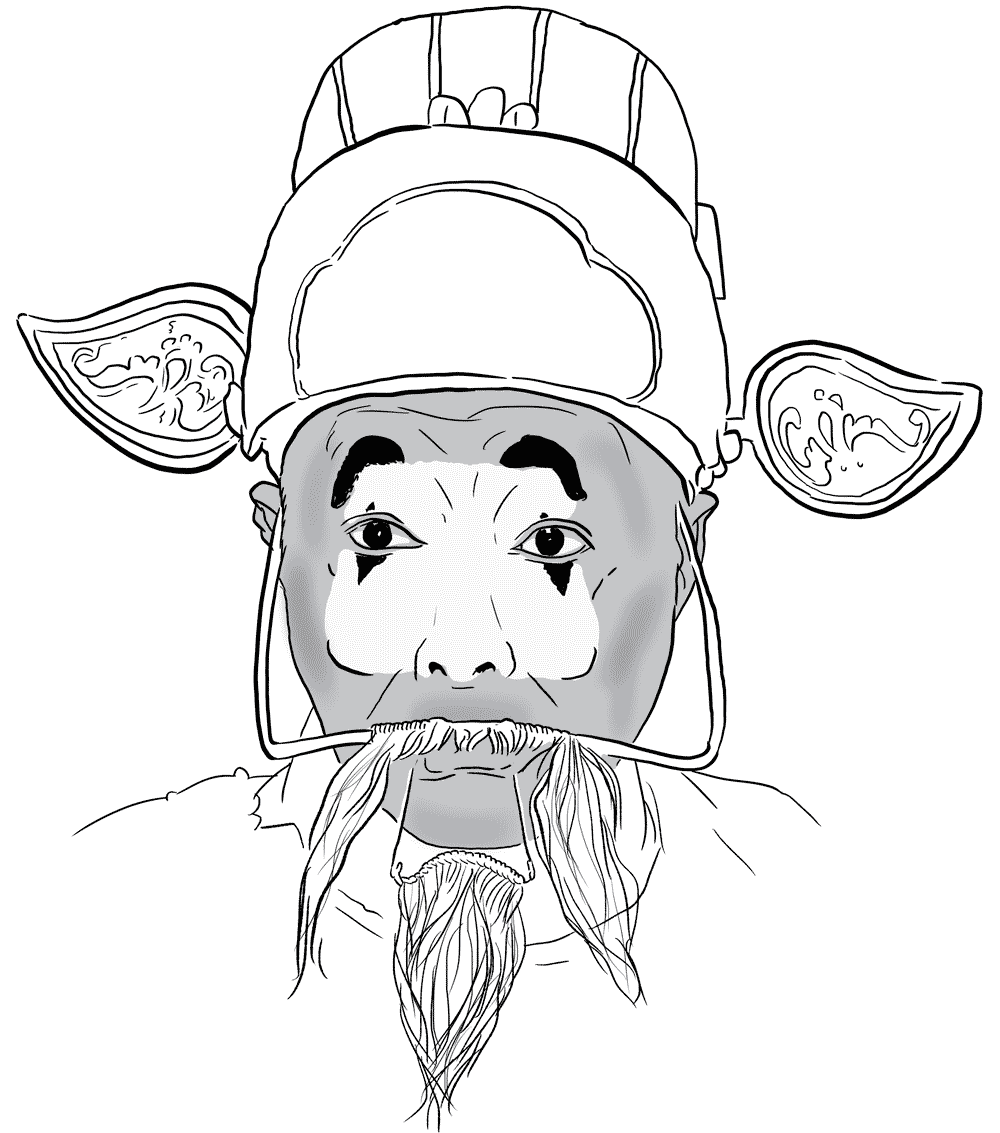
6- ZHENGYIN WUSHENG
Wu Sheng roles are for male military characters who appear in battle scenes. A high level of martial arts skills is necessary to play this role. It requires vigorous exertions using powerful waist and leg movements. The actors also need to make resounding declamations.
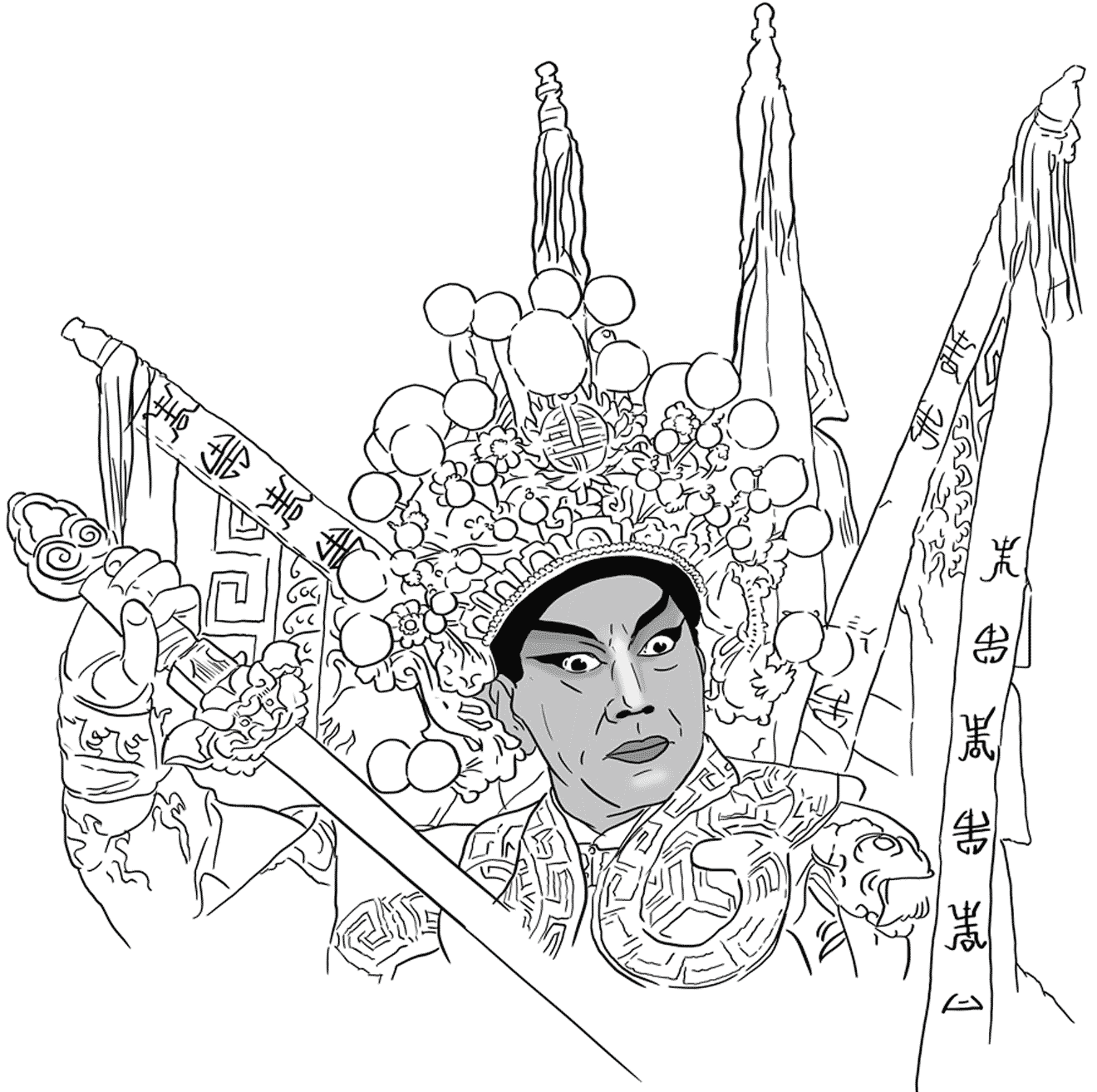
KEEP SCROLLING
THE SKILLS
Wang Guowei (1877-1927), was a Chinese scholar, historian, literary critic, and poet known for his Western approach to Chinese history. Wang has defined Cantonese opera, xiqu as “story-telling through singing and dancing”. He believed it was a comprehensive multi-disciplinary artform using vocals, instrumental music and dancing to tell a story.
The following concepts are essential for understanding the style and characteristics of Cantonese opera.
"Chang, zuo, nian and da" are the basic requirements of a xiqu performer
Chang
Refers to an actress or actor’s changqiang (singing). S/he has to sing with different changqiang to match the role being played.

Zuo
Refers to the skills of the performer in bodily movement and hand gestures, as well as the acting and emotional expressions required on stage.
Nian
Refers to nianbai, which means recitation. It constitutes spoken narration in xiqu. Yet the manner of delivery is different from daily life, it is more musical and rhythmic. Examples of nianbai are koubai, kougu, shibai and bailan, etc.
Da
Refers to the acrobatic fights featured in Cantonese operas, including bazigong (with weapons) and tanzigong (without weapons).
The appreciation of Chinese xiqu centres around suggestive dance-like gestures, exaggerated movements and a level of abstraction. On stage, xiqu actors perform using various dance-like gestures, wearing painted faces with exaggerated colours and lines. They also use abstract movements to represent different times and spaces, such as going up and down a staircase, or opening and closing doors.

COSTUME DESIGN
In the early days of Cantonese opera there was no strict convention concerning the costumes of the actors, which imitated the designs of the Ming Dynasty (1368-1644). Towards the end of the Qing Dynasty in the early 20th century, the plots of Cantonese opera focused on social realities of the time and the costumes were more casual and closer to Western styles.
Later, due to the constant exchange of actors between Cantonese and Peking opera and also with the aim of attracting a larger audience, the costumes became much more striking. Sequined and beaded costumes were used and sometimes tiny electric light bulbs were employed.
The current trend is to use embroidered theatrical costumes, which are determined by sex, role, plot, personality, environment and occasion.
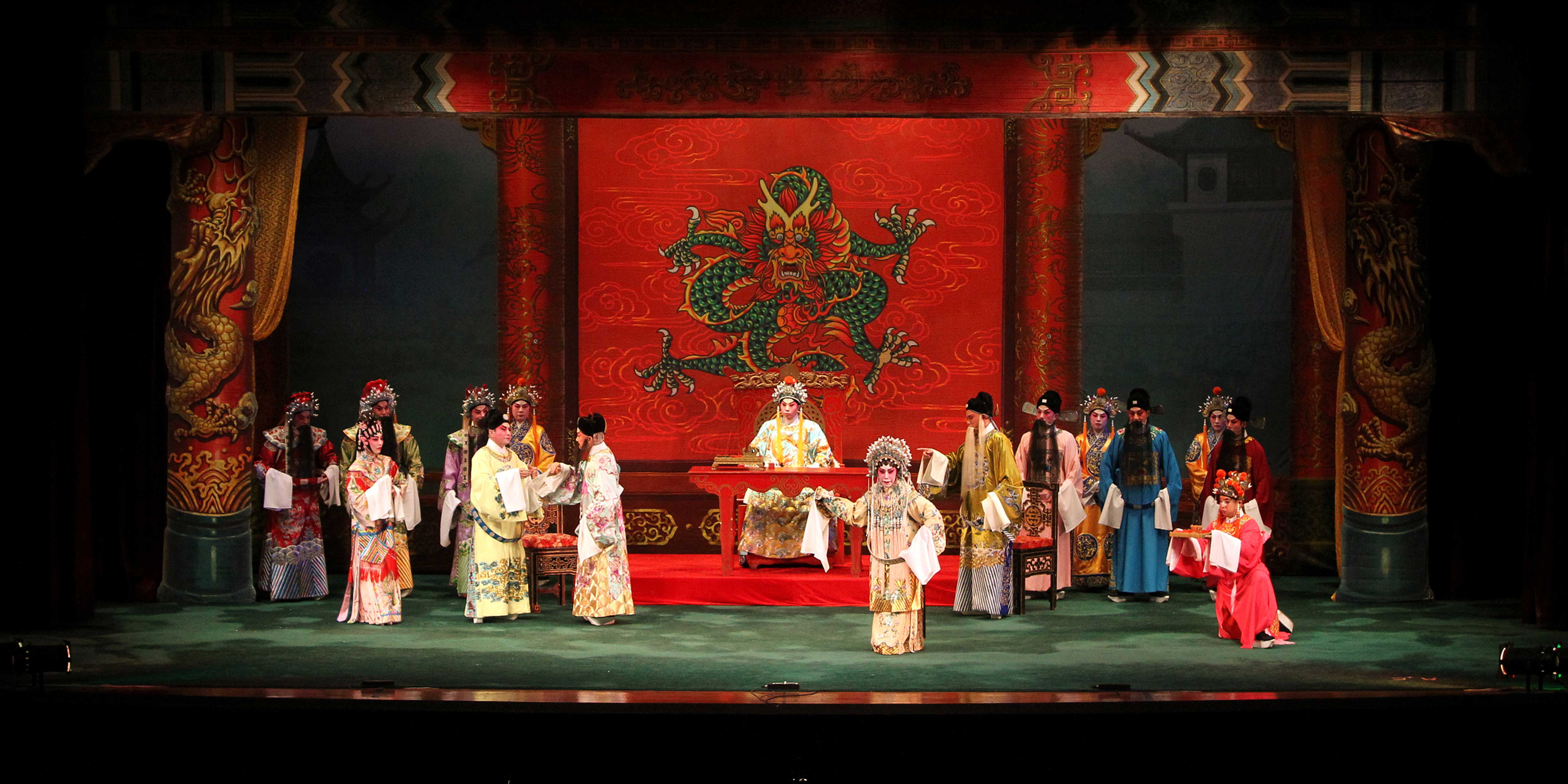
Costumes are basically classified into python ceremonial robes, armour, gowns with sloping collars, cloaks, official robes, gowns with vertical collars, coats and so on. Each type of costume is matched with particular headgear, footwear and facial make-up.
In this discipline, there are two types of outfits that are defined by the script. Mun which is less intricate, are often double-breasted and tied at the side, while others are single-breasted and buttoned. Some have round necks around the shoulders. This style of dress represents more casual or daily routine environments.
Mo is usually more elaborate with ornaments and heavier elements. This is used for special circumstances such as battles, ceremonies or important missions.
MEN'S COSTUMES SAMPLES
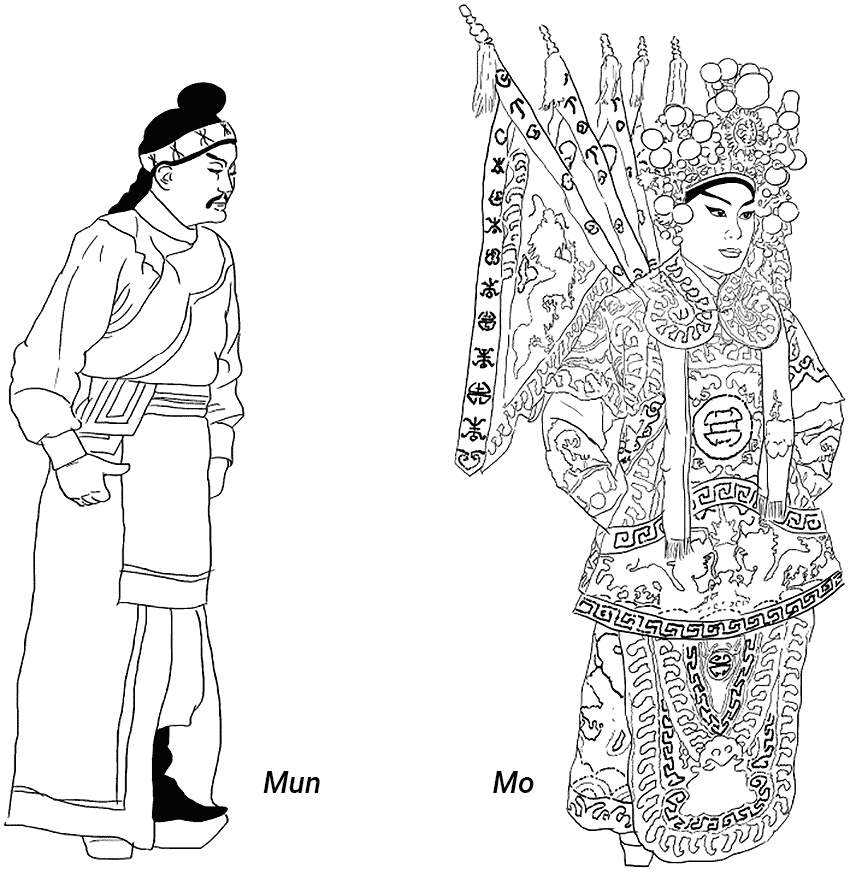
WOMEN'S COSTUMES SAMPLES
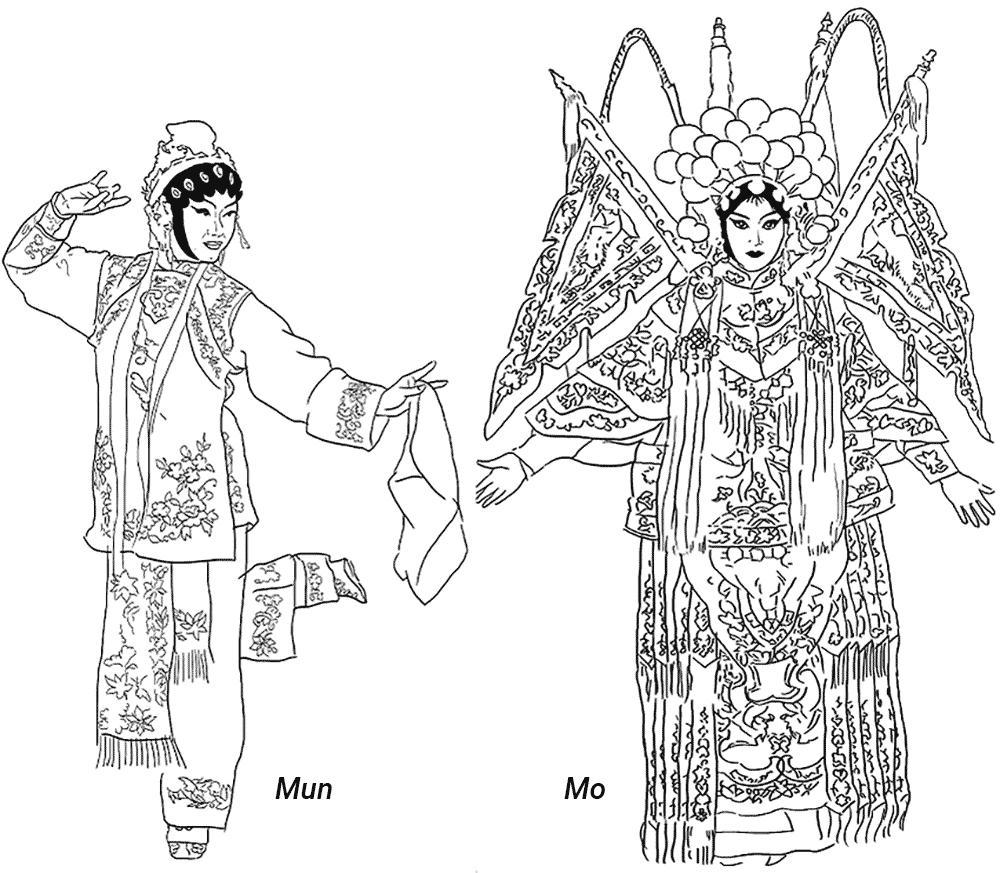
KEEP SCROLLING
THE MAKE-UP
The origin of the unique style of make-up dates back to early performances where artists used heavy cosmetics to counter the poor stage lighting and distance from the audience. Different formulas were applied to symbolise the characteristics of each role and help enhance the narrative.  A character’s make-up had its own distinct characteristics and according to the usual practice, all artists had to apply their own make-up. These traditions still apply today.
A character’s make-up had its own distinct characteristics and according to the usual practice, all artists had to apply their own make-up. These traditions still apply today.


One of the most common styles is the "white and red face". The face is covered in white foundation with red painted around the eyes fading down the cheeks. The eyebrows are long and the lipstick is usually bright red.
Besides the iconic white and red face, actors also paint their faces with distinctive patterns and colours to symbolise their emotions and/or roles. Heavy make-up also helped males to be more convincing in female roles.


PERFORMING
The actors often describe their gestures and stage movements as symbolic and ornamental. They performed with exaggerated actions to help the audience understand the plot. To represent outdoor scenes they carry out movements as shown in the samples below:
SPEED WALKING
One of the most basic but difficult movements is speed walking, affectionately called the ‘round table’. This graceful movement symbolises travelling a long distance.
HORSE RIDING
As it is impossible to bring a real horse onto the stage a series of symbolic movements represent this action.

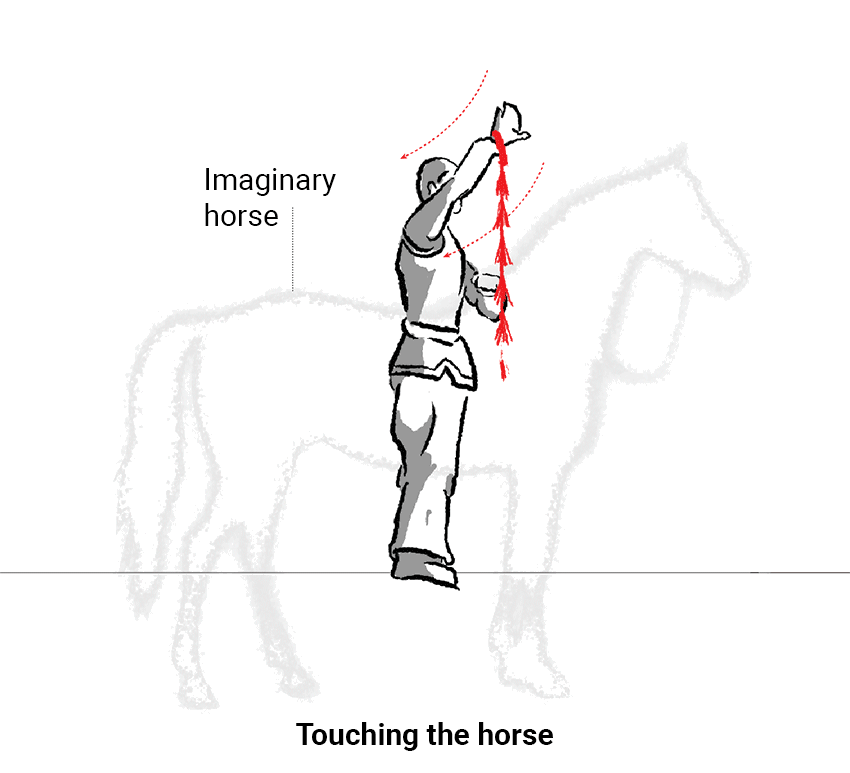
ACROBATIC MOVES
Used to symbolise dangerous conditions such as descending from a cliff. Actors can demonstrate their acrobatic or martial arts skills by performing complicated moves much to the delight of the audience.

THE STAGE
The size of the stage varies depending on the type of theatre. Permanent theatres have larger stages while temporary constructions near a temple will have a smaller stage. Actors must adapt the plot and stage scenery according to the conditions. Originally scenery was quite simple, with landscapes painted on a backdrop while a table and two chairs could be arranged symbolically on the stage to represent a bridge, a mountain, an emperor’s throne, or even a bed. When the opera moved to modern theatres, the symbolic use of props became redundant.
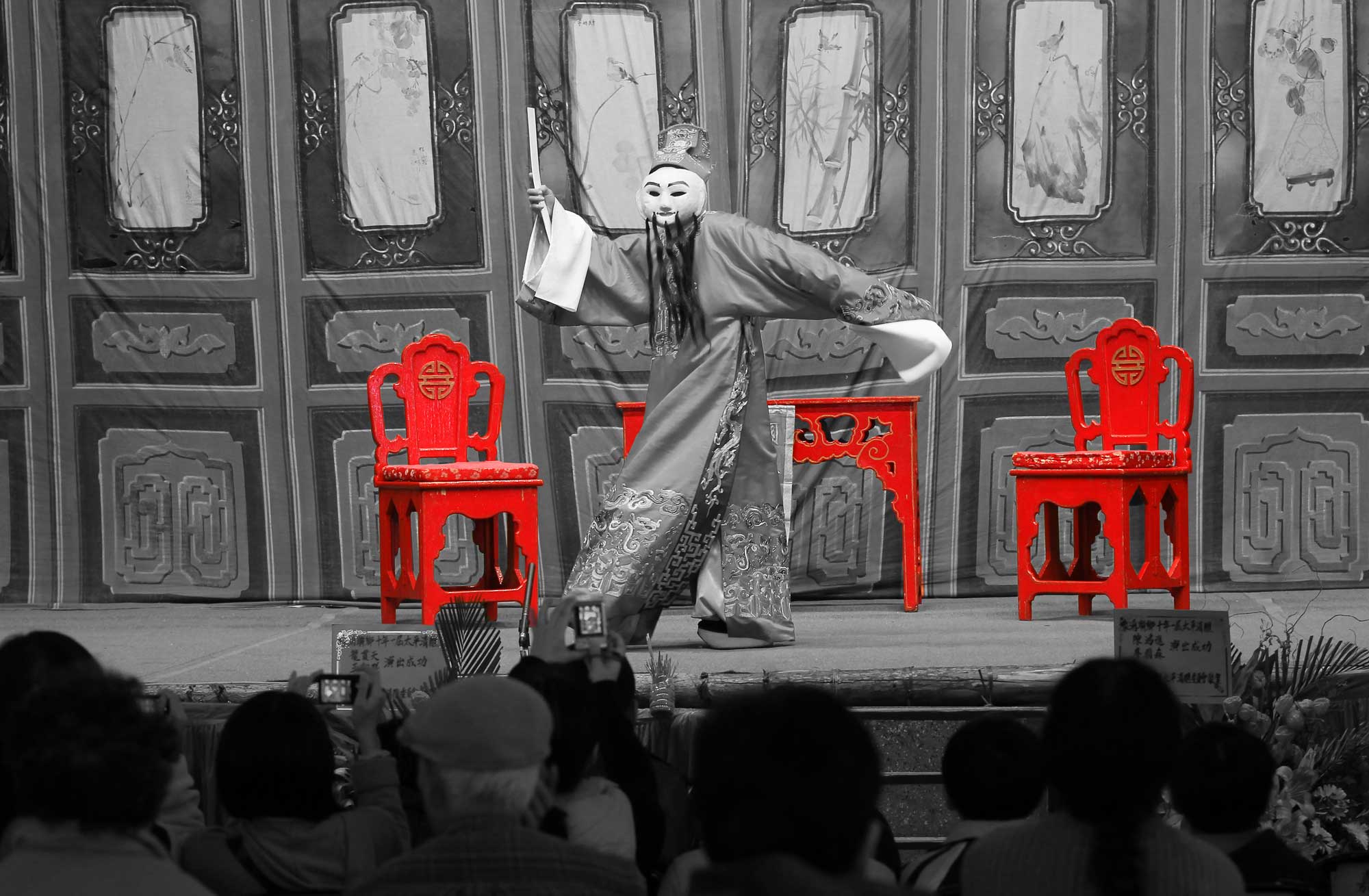
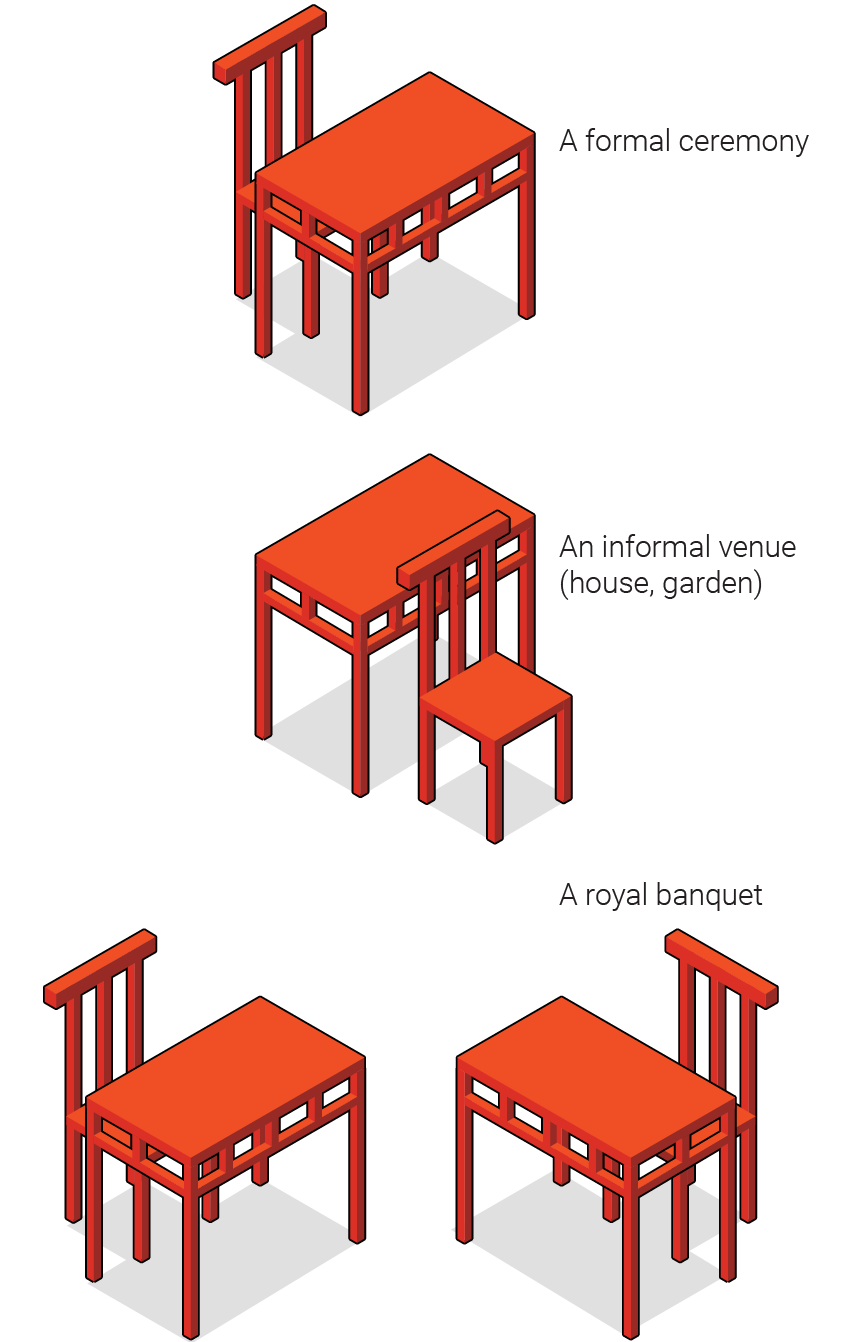
THE MUSIC
The lyrics are essential to Chinese opera but unlike traditional Western opera, the music has a less important role. The writers place the words in a general melodic frame as the plot develops. The songs can contain many melodies and the singers can add personal variations in their own style.
The orchestra consists of two sections; the percussion and melodic groups. Each has a director with a flexible number of musicians under his direction.
The percussion is made up of various cymbals and drums and sets the general rhythm of the play, movement of the actors, intensity of the scenes, etc.
Several western instruments such as cello, saxophone and violin have been incorporated and are now regularly included in repertoires.
THE INSTRUMENTS
Here are some of the instruments:

